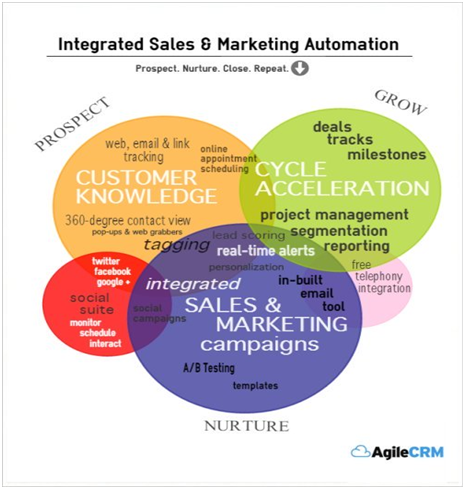Sales CRM with Marketing: Why you Need it for your Small Business
If marketing empowered just one sales rep to close a deal, you would see how Sales would become eager to do whatever it takes to help Marketing do more of the same. In other words – help Sales succeed, and they will be driven and dedicated to show even more results.
To strive for Marketing and Sales alignment means making this happen: Marketing generates demand and works to pass off only the most sales-ready leads to Sales, and Sales further works with customer data to improve the sales process, inadvertently helping Marketing with their efforts. But how do we achieve this experience in order to propel both teams to success?
According to CMO Council, lost productivity and poorly managed leads cost companies at least $1 trillion every year. What’s more is that according to RedBase Interactive, leads that are nurtured purchase 47% more than non-nurtured leads. What we are seeing here is that the marketing department plays a critical role for Sales. This is why alignment is so important.
Highly aligned businesses achieve a significant rise in revenue growth, while less aligned competitors see a decrease. Yet, according to a study from Forrester, just 8% of companies say they have tight alignment between sales and marketing. The moral of the story? When marketing and sales work together, they can achieve their goals and that happens when a CRM is integrated with Marketing.
Let’s explore the sales funnel.
The better we understand the sales cycle in its relation to leads, the more we are able to set common sets of definitions of what each stage of the funnel means, and when we make this happen, we have a clearer picture of how Marketing and Sales function together.
A typical sales cycle is segmented into five stages:
 Stage 1: Lead Capture
Stage 1: Lead Capture
A prospect has a problem. They are on the search for a solution on the Web, but aren’t quite familiar with what they need and what they’re looking for. Your business comes up after a quick search and a customer shows interest by filling out a form on your website. It may have been for a white paper download, or an industry report. You’ve captured a lead! Great news!
Stage 2: Marketing-Qualified Lead (MQL)
Once you’ve captured a lead, it becomes marketing-qualified. What does this mean? This means that the lead is now in the hands of the marketing team and is ready to be nurtured. According to MarketingSherpa, 79% of marketing leads never convert into sales, and lack of lead nurturing is the reason. It’s critical for a lead to be nurtured in order for it to become ready for Sales. Lead nurturing techniques like email campaigns, social media interaction, and further sharing of industry knowledge via content marketing happen at this stage.
Stage 3: Sales-Qualified Lead
Can Sales further nurture leads? Absolutely! The right platform enables sales reps to further engage and nurture leads using the many features in marketing automation – email, SMS, call tracking, landing pages and forms all help sales teams to come closer to the end goal – a closed sale.
Stage 4: Opportunity
Now that contacts are in your CRM, they have become opportunities because we know what their needs are, our product is inline with them, and our proposal has been accepted.
Stage 5: Closed Sale
No brainer! We got the business.
Data Leaks
When we apply demand generation activities and tactics, and work to convert prospects into paying customers, if Marketing and Sales aren’t in alignment we are faced with a broken sales funnel. We need to know when and why a lead is qualified, and when we align marketing processes with a CRM, we decrease leaks in data transfer, rid Marketing and Sales of operating in a silo, and make a seamless transition from marketing-qualified to sales-ready leads.
The need for marketing to measure campaigns and activities before, during and after campaign execution is critical. And, with the growing amount of buyers in the sales funnel, and leads that are continuously moving in and out of it, measuring ROI becomes essential.
ROI Measurement
ROI is one of the most important KPIs. 81% of marketers would increase spending on digital, mobile, and social channels if they could better track ROI. If you ask a marketer what they do and what they measure, they are likely to say that most of their focus is on day-to-day activities, with no focus on attributing marketing processes directly to revenue. For this reason, they don’t get better at executing results-driven campaigns. Without this critical KPI, Marketing can’t effectively decide which campaigns to spend more time and money on.
Integrating a CRM with Marketing A recent study by SiriusDecisions found that B2B organizations with tightly aligned marketing and sales teams achieved 24% faster revenue growth and 27% faster profit growth over a three-year period. This makes a CRM a critical tool for small business. The marketing team and a CRM are the cornerstones for prospecting, nurturing, closing and repeating business (See figure 2). By ensuring sales and marketing campaigns are integrated, customer knowledge is available and all touchpoints are documented for Marketing and Sales to view at any given time, your business is able to better understand customer behavior and deploy consistent messaging across the teams. How effective is your sales and marketing process? Do you have a clear sales funnel marked by each sales stage? You may need a CRM to enable both Marketing and Sales to realize revenue goals together.
A recent study by SiriusDecisions found that B2B organizations with tightly aligned marketing and sales teams achieved 24% faster revenue growth and 27% faster profit growth over a three-year period. This makes a CRM a critical tool for small business. The marketing team and a CRM are the cornerstones for prospecting, nurturing, closing and repeating business (See figure 2). By ensuring sales and marketing campaigns are integrated, customer knowledge is available and all touchpoints are documented for Marketing and Sales to view at any given time, your business is able to better understand customer behavior and deploy consistent messaging across the teams. How effective is your sales and marketing process? Do you have a clear sales funnel marked by each sales stage? You may need a CRM to enable both Marketing and Sales to realize revenue goals together.

1 Comment